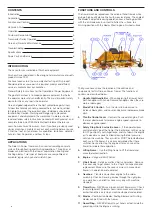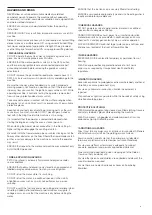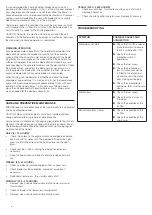
6
It is recommended that, during floating, blades be kept in a flat
position with the trowel working at ½ to ¾ of the full speed, and each
pass should overlap the previous by half the width of the trowel. A
second trowel pass may be required for the desired finish. Crossover
floating is recommended for this pass with blade pitch at a slightly
higher level and trowel at about ¾ of the full speed.
Under normal operating conditions the machine may cover as much
as 90 square metres in about 15 minutes. After the floated slab has
set sufficiently it is ready for the finishing operation.
CAUTION: Do not let the machine stand in one spot on the soft
concrete. Lift the trowel safely by 2 persons or mechanical aids from
the slab when the floating operation is completed.
FINISHING OPERATION
For a good concrete surface finish, the operator should adjust the
blade pitch based on the hardness or plasticity of the concrete
surface. When the concrete is wet or plastic, begin with the blades
lying flat or at a small angle on the surface. When the concrete has
sufficiently hardened, increase the blade pitch and keep it at a level
corresponding to the concrete hardness and the desired finish. Check
the obtained finish, and adjust the blade pitch as necessary. As a
rule the greater the blade pitch, the smoother the finish. However,
excessive blade pitch will cause the blades to wear rapidly.
When finishing, run the trowel at full throttle, and keep the blade
coverage at approximately 10 cm on each turn. Let the trowel move
right or left, backwards or forwards approximately 10 cm with each
revolution of the trowel blades. To fill a hole or cut down a hump,
move the unit back and forth over the hole or hump. More passes
may be needed for the desired surface finish.
CARE AND PREVENTIVE MAINTENANCE
ENSURE repairs and maintenance of the trowel machine is performed
only by qualified personnel.
CAUTION: Make sure the engine is shut down, isolated and cool
enough before performing repairs and maintenance.
For preventive maintenance of the engine, please refer to the Owner’s
Manual of the Honda engine supplied with the Ride on Power trowel.
The following schedule should be followed when performing regular
maintenance of the trowel:
DAILY (8 – 10 HOURS)
•
Check the oil level in the engine crankcase and gearbox before
each use, refill as necessary. The gearbox is fitted with a sight
glass, maintain the oil level at the half way level on the sight
glass.
•
Check that the V-belt is running true. Adjust or replace as
necessary.
•
Keep the trowel clean and free of concrete residue after each
use.
WEEKLY (50 – 60 HOURS)
•
Check and clean or replace engine air filter as necessary.
•
Check blades for their condition, and adjust or replace if
necessary.
•
Relubricate trowel arms, thrust collars and clutch.
MONTHLY (200 – 300 HOURS)
•
Remove, clean, reinstall and relubricate the trowel arms and
thrust collars.
•
Check and adjust the trowel arms for alignment
•
Remove, clean, reinstall and relubricate the clutch.
YEARLY (2000 – 2500 HOURS)
•
Check arm bushings, thrust collar bushings, and shaft seals.
Replace if necessary.
•
Check the pitch control cable for wear. Replace if necessary.
TROUBLESHOOTING
SYMPTOM
POSSIBLE CAUSES AND
CORRECTION
Motor does not start
Check the ON/OFF or dead
mans foot switch to ensure
that it is switched to “ON”
Check the runaway
protection switch is
operational
Check the fuel supply
Check the crankcase oil
level. An oil sensor device
is fitted to the motor, low
oil level prevents the motor
from starting or stopping
Check the carburettor jet
and bowel to ensure they are
clean
Motor stops
Check the fuel supply
Check that the fuel cock is
turned on
Check the condition of the
air filter
Petrol motor lacks power
Check the condition of the
air filter
Check the condition of the
spark plug








